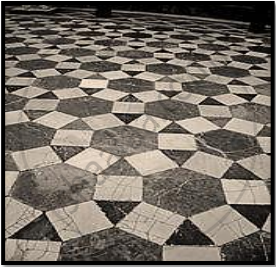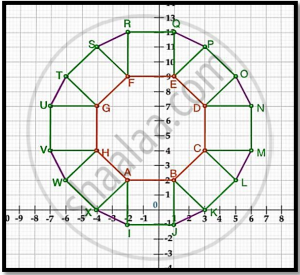Advertisements
Advertisements
Question
If the points A(−2, 1), B(a, b) and C(4, −1) ae collinear and a − b = 1, find the values of aand b.
Solution
The given points A(−2, 1), B(a, b) and C(4, −1) are collinear.
\[\therefore \text{ ar } \left( ∆ ABC \right) = 0\]
\[ \Rightarrow \frac{1}{2}\left| x_1 \left( y_2 - y_3 \right) + x_2 \left( y_3 - y_1 \right) + x_3 \left( y_1 - y_2 \right) \right| = 0\]
\[ \Rightarrow x_1 \left( y_2 - y_3 \right) + x_2 \left( y_3 - y_1 \right) + x_3 \left( y_1 - y_2 \right) = 0\]
\[\Rightarrow - 2\left[ b - \left( - 1 \right) \right] + a\left( - 1 - 1 \right) + 4\left( 1 - b \right) = 0\]
\[ \Rightarrow - 2b - 2 - 2a + 4 - 4b = 0\]
\[ \Rightarrow - 2a - 6b = - 2\]
\[ \Rightarrow a + 3b = 1 . . . . . \left( 1 \right)\]
Also, it is given that
a − b = 1 .....(2)
Solving (1) and (2), we get
\[b + 1 + 3b = 1\]
\[ \Rightarrow 4b = 0\]
\[ \Rightarrow b = 0\]
Putting b = 0 in (1), we get
\[a + 3 \times 0 = 1\]
\[ \Rightarrow a = 1\]
Hence, the respective values of a and b are 1 and 0.
APPEARS IN
RELATED QUESTIONS
Find the distance between the following pair of points:
(a, 0) and (0, b)
Which point on the x-axis is equidistant from (5, 9) and (−4, 6)?
If G be the centroid of a triangle ABC, prove that:
AB2 + BC2 + CA2 = 3 (GA2 + GB2 + GC2)
Name the quadrilateral formed, if any, by the following points, and given reasons for your answers:
A(-1,-2) B(1, 0), C (-1, 2), D(-3, 0)
If the point P (2,2) is equidistant from the points A ( -2,K ) and B( -2K , -3) , find k. Also, find the length of AP.
Show that the points A(2,1), B(5,2), C(6,4) and D(3,3) are the angular points of a parallelogram. Is this figure a rectangle?
Show that the following points are the vertices of a rectangle
A (0,-4), B(6,2), C(3,5) and D(-3,-1)
Points P, Q, and R in that order are dividing line segment joining A (1,6) and B(5, -2) in four equal parts. Find the coordinates of P, Q and R.
Find the coordinates of the midpoints of the line segment joining
A(3,0) and B(-5, 4)
In what ratio is the line segment joining the points A(-2, -3) and B(3,7) divided by the yaxis? Also, find the coordinates of the point of division.
Find the area of quadrilateral PQRS whose vertices are P(-5, -3), Q(-4,-6),R(2, -3) and S(1,2).
If the vertices of ΔABC be A(1, -3) B(4, p) and C(-9, 7) and its area is 15 square units, find the values of p
Find the value of a, so that the point ( 3,a ) lies on the line represented by 2x - 3y =5 .
Points (−4, 0) and (7, 0) lie
The ordinate of any point on x-axis is
If P (x, 6) is the mid-point of the line segment joining A (6, 5) and B (4, y), find y.
The ratio in which (4, 5) divides the join of (2, 3) and (7, 8) is
Which of the points P(-1, 1), Q(3, - 4), R(1, -1), S (-2, -3), T(-4, 4) lie in the fourth quadrant?
Statement A (Assertion): If the coordinates of the mid-points of the sides AB and AC of ∆ABC are D(3, 5) and E(–3, –3) respectively, then BC = 20 units.
Statement R (Reason): The line joining the mid-points of two sides of a triangle is parallel to the third side and equal to half of it.
A tiling or tessellation of a flat surface is the covering of a plane using one or more geometric shapes, called tiles, with no overlaps and no gaps. Historically, tessellations were used in ancient Rome and in Islamic art. You may find tessellation patterns on floors, walls, paintings etc. Shown below is a tiled floor in the archaeological Museum of Seville, made using squares, triangles and hexagons.

A craftsman thought of making a floor pattern after being inspired by the above design. To ensure accuracy in his work, he made the pattern on the Cartesian plane. He used regular octagons, squares and triangles for his floor tessellation pattern

Use the above figure to answer the questions that follow:
- What is the length of the line segment joining points B and F?
- The centre ‘Z’ of the figure will be the point of intersection of the diagonals of quadrilateral WXOP. Then what are the coordinates of Z?
- What are the coordinates of the point on y-axis equidistant from A and G?
OR
What is the area of Trapezium AFGH?
